How to choose a ripe and sweet watermelon: what to look for when buying and choosing a fruit in the garden
Watermelon is not only tasty, but also a valuable product. With the frequent use of fruit pulp, general well-being improves, metabolism, weight normalize, the risk of developing diseases of the heart, blood vessels, and digestive organs decreases. The berry has a positive effect on the skin condition: nourishes, moisturizes, slows down the aging process, stimulates tissue renewal and growth. However, not every watermelon has useful qualities: fruits accumulate nitrates, which cause stomach pain, vomiting, nausea, and diarrhea.
Consider how to choose a ripe and sweet watermelon in the market, in the store or in the garden, what to look for, and how to check the nitrate content at home.
The content of the article
How to choose a watermelon
The safest option is to use your own harvest watermelons. Or grown in guaranteed normal conditions in compliance with all technologies. Buying fruit at the market or in the store, you run the risk of purchasing fruits grown with an excess of fertilizers.
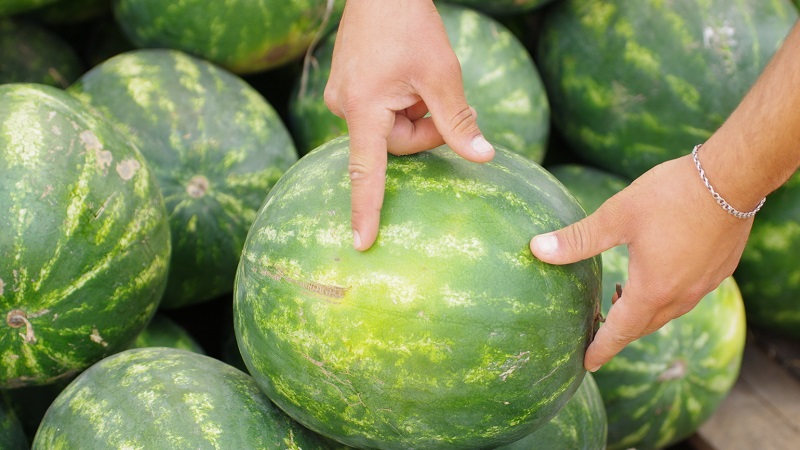
When growing melons and gourds, manufacturers use various agrochemicals, growth stimulants, and pest control agents that are toxic to the body.
When buying a fruit, you need to correctly assess its quality, check for ripeness. First of all, they are guided by appearance, color, aroma, smell:
- What does a good watermelon look like? He has a dense peel without traces of damage, damage, stripes are clear and bright. The top layer is shiny, without a matte coating. On the side there is a small yellow earthen spot (5–10 cm).
- Fruits with a green scent may be unripe. Mature ones have a neutral odor.
- You cannot buy a watermelon without a tail, since the ripeness of the fruit is determined by it. A sign of a ripe and tasty watermelon is a moderately dry stalk. A green tail indicates that the berry has not reached ripeness, too dry - that it has been stored for a long time or is already overripe.
- There are melons and gourds on the basis of gender. The male berry has a convex bottom with a small circle. "Girls" are smaller, have a flattened shape, a flat bottom with a wide circle. In terms of taste, women's watermelons are sweeter and contain fewer seeds.
- Ripe fruit cracks when squeezed, emits a booming sound when you tap the rind with your hand.
- Ideally, the weight is 5-10 kg. If you choose too large a fruit, then there is a possibility of its oversaturation with nitrates. The small berry has not yet had time to grow, ripen, so it will be savory and green inside.
Place and time of purchase
Be sure to ask the seller for a certificate of the State Sanitary and Epidemiological Supervision or other documents certifying the quality of the watermelon. It is better to buy melons and gourds in specially designated and equipped places in the market or near the field where they grew.
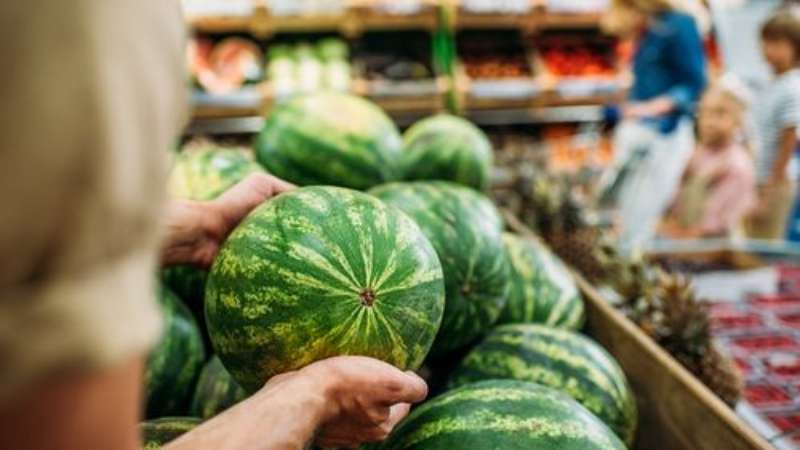
Experts advise not to buy fruit near the track, as the pulp absorbs road dust and dirt through the peel.
Important! Pay attention to the storage conditions of the fruit. They must be in special pallets with a height of at least 0.2 m so as not to come into contact with the ground. Selling points should be under a canopy.
You can not eat watermelons before August: the period from mid-August to the end of September is the time of the ripening of culture in nature. Earlier varieties contain many nitrates, which cause oxygen starvation, intoxication, disrupt the functions of the gastrointestinal tract and increase the risk of cancer.
Tips for choosing a good fruit
Food quality experts share tips on how to choose a delicious sweet and healthy watermelon:
- A perfectly shaped berry may be tasty, but not healthy: most likely, such a watermelon was grown with the addition of pesticides. The sweet and natural fruit often has an irregular shape, sufficient (up to 10 kg) weight, a yellow spot on the side.
- Do not buy melons and gourds with traces of adhering dirt: they contain harmful microorganisms that, if they enter the stomach, can cause intoxication, worsen general well-being and health.
- Do not ask the seller to make an incision in the watermelon, as it is not known in what sanitary conditions the knives are stored - microbes can penetrate the pulp through the dirty skin.
- Dip the fruit in water: ripe and juicy will stick to the surface.
- Seeds ripe berries are dark brown, closer to black. They are eaten after being fried in a pan or oven. Such grains are used as a medicine. White bones are a sign of nitrate pulp or an unripe fruit; they are not suitable for food.
- In an unripe watermelon, if the skin is damaged with a nail, juice will be released, and a herbal smell will appear.
- Before use, the fruit is thoroughly washed with a brush or sponge, wiped dry with a towel.
- A whole ripe watermelon can be stored for 3 months, cut - no more than 3 days. Leave the berries in the refrigerator or dark cool place under cling film.
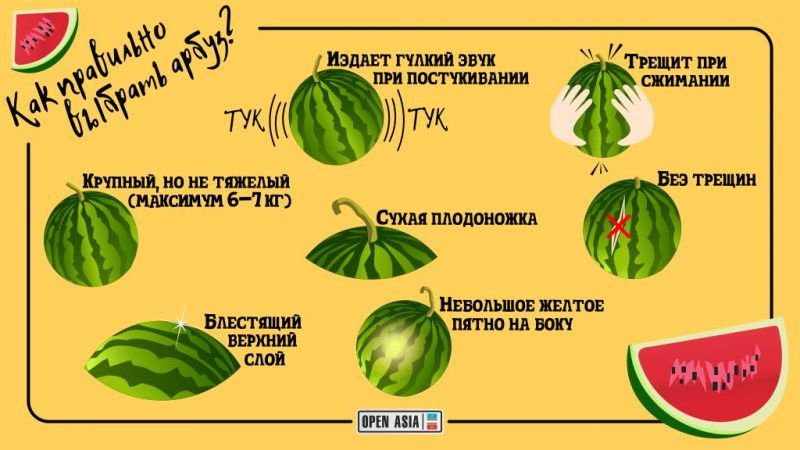
Testing for nitrates
It is not possible to visually determine if the fruit pulp contains nitrates or other harmful chemicals.
The easiest way to assess the safety of a fruit is to use a nitrate tester.... The standards for the content of harmful substances for all products are already stored in the device's memory. The screen will turn green if the nitrate content is normal and the product is safe, yellow - if it is slightly exceeded, red - if the product is dangerous.
Determine the presence of nitrates at home by the fruit pulp. In a safe watermelon, it is red, has grains and white veins, nitrate - smooth, purple with yellow veins. Another way to test is to stir a small piece of pulp in water. If the berry is natural, the liquid will become cloudy. Rose water is a sign of a poor quality fruit.
For reference! The largest amount of nitrates is found in the peel and white pulp. Therefore, if you suspect that the fruit is unsafe, eat it gently, not reaching the white border with the crust.
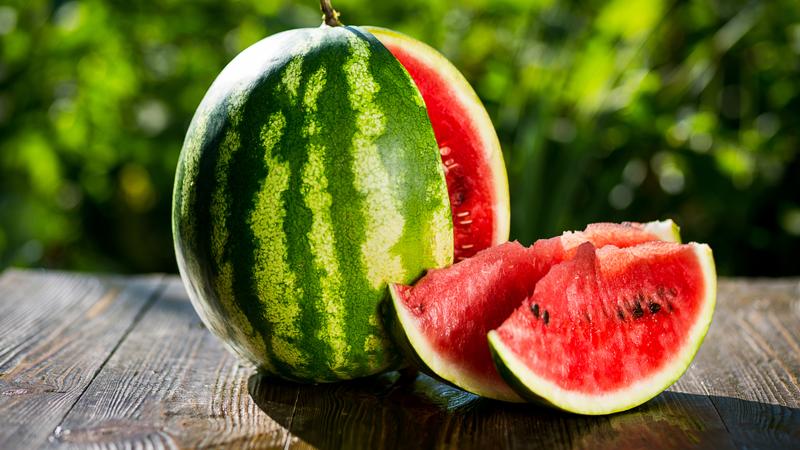
Choosing a watermelon in the garden
How to check the ripeness of a watermelon in the garden? Here they rely on the same signs of a ripe fruit:
- dry yellow tail, but not overdried;
- dried antennae at the place where the stalk is attached to the whip;
- booming sound when tapped;
- yellow earthen spot on the side no more than 10 cm;
- pronounced striped pattern;
- shiny top layer without matte plaque;
- large, but not heavy fruit;
- crackle when squeezed with hands on the sides;
- hard bark (if the berry is immature, it is easy to push the peel with a fingernail).
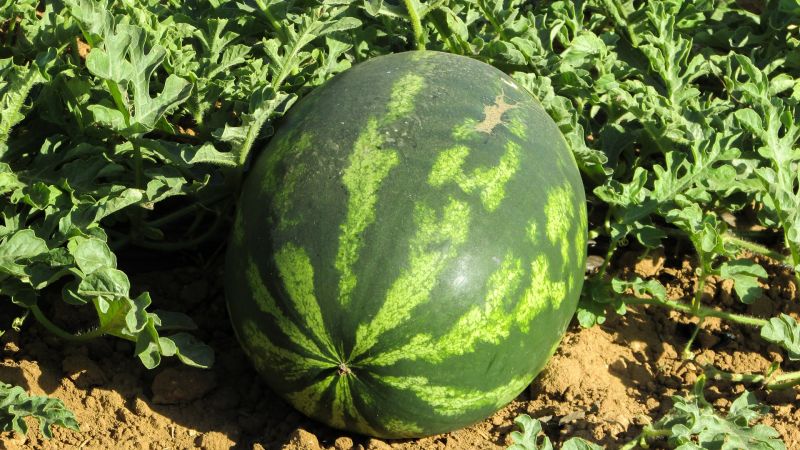
Read also:
Is there a blue watermelon or is it an internet myth.
Is it possible to eat watermelon on an empty stomach.
Simple and delicious recipes for making watermelon marmalade.
Conclusion
It is advisable to use melons and gourds of your own harvest: only in this case you can be sure of the quality of the product - it remains only to determine the ripeness of the fruits and harvest on time.
When buying at the market or in a store, there is a chance of purchasing a nitrate product. Knowing the external signs of a ripe and sweet watermelon, it is easier to choose it, reducing the risk of poisoning with harmful substances.